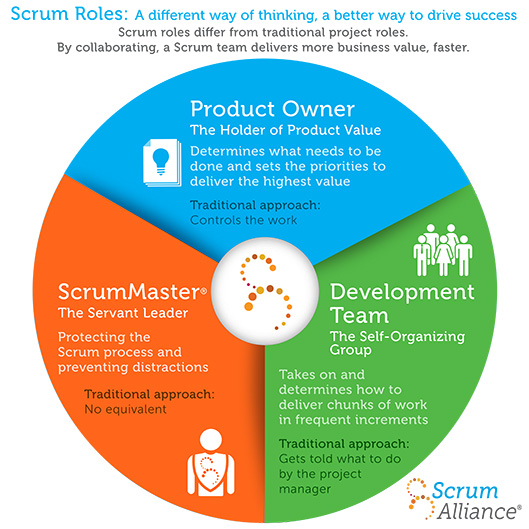Scrum Team
Scrum defines three roles: ScrumMaster, Product Owner, and Development Team. Together all three roles make up a Scrum Team.
Please note, the following information comes from the thought leadership of our Certified Scrum Trainers and Certified Agile Coaches, as well as other reputable sources, including the Agile Manifesto and the November 2017 version of the Scrum Guide.TM
Product Owner Role & Responsibilities
The Product Owner defines the what–as in what the product will look like and what features it should contain. The Product Owner is expected to incorporate stakeholder feedback to create the highest value product increments each and every sprint. Product Owners maintain the product backlog and ensures that everyone knows the priorities.
Product Owners perform the following activities:
- Clearly express product backlog items;
- Order the items in the product backlog to best achieve goals and missions;
- Optimize the value of the work the development team performs;
- Ensure that the product backlog is visible, transparent, and clear to all, and shows what the Scrum Team will work on next;
- Ensure the development team understands items in the Product Backlog to the level needed.
Traits of Great Product Owners
Like ScrumMasters, product owners vary in their specific mix of skills and qualifications, but most product owners work toward developing:
Product Owner Attributes
- Empowered. Has decision-making authority for the product.
- Business-savvy. Knows the business, the customer and the market.
- Persuasive. Able to work well with the team and the stakeholders.
- Knowledgeable. Knows the market and the product. Grasps production challenges.
- Available: Is readily accessible to the team and to the stakeholders.
Product Owner Functions
- Customer Voice: Represents the customers wants and needs.
- Communicator: Knows how to tailor a message to a wide variety of stakeholders
- Decider. Sifts through competing priorities to choose the right product features and says no to the rest.
Development Team Role & Responsibilities
The Development Team decides how to accomplish the work set forth by the Product Owner. Development Teams are structured and empowered to organize and manage their own work. The resulting synergy optimizes overall efficiency and effectiveness.
Development Team Characteristics
Development teams have the following characteristics:
- They are self-organizing. No one (not even the ScrumMaster) tells the development team how to turn Product Backlog into Increments of potentially releasable functionality;
- Development teams are cross-functional, with all the skills as a team necessary to create a product Increment;
- Scrum recognizes no titles for development team members, regardless of the work being performed by the person;
- Scrum recognizes no sub-teams in the development team, regardless of domains that need to be addressed like testing, architecture, operations, or business analysis; and,
- Individual development team members may have specialized skills and areas of focus, but accountability belongs to the development team as a whole.
Development Team Size
The ideal size for a development is between 3 and 9 people, not including the ScrumMaster and product owner. Any smaller and the team couldn’t accomplish enough each sprint. Any larger and communication becomes complex and cumbersome.
ScrumMaster Role & Responsibilities
The ScrumMaster helps the Scrum Team perform at their highest level. They also protect the team from both internal and external distractions. ScrumMasters hold the Scrum Team accountable to their working agreements, Scrum values, and to the Scrum framework itself.
Traits of Great ScrumMasters
Entire books have been written on what makes a great ScrumMaster, but most experts generally agree on the following:
ScrumMaster Attributes
- Humble. Credits the team, not themselves.
- Respectful. Treat others as whole, creative, and purposeful beings with positive intent.
- Empathetic. Listens to understand. Is comfortable with silence.
- Persuasive. Works to remove impediments throughout the organization.
- Connected. Knows who to talk to (or finds out) to solve problems and resolve issues.
ScrumMaster Functions
- Coach: Facilitates meetings, conversations, and improvements.
- Protector: Runs interference so the team can remain focused.
- Servant Leader. Leads without authority and puts the team first.
- Agile Advocate: Reinforces agile principles throughout the organization.
Ways ScrumMasters Serve Product Owners
The ScrumMaster serves the Product Owner by:
- Ensuring that goals, scope, and product domain are understood by everyone on the Scrum Team as well as possible;
- Finding techniques for effective product backlog management;
- Helping the Scrum Team understand the need for clear and concise product backlog items;
- Understanding product planning in an empirical environment;
- Ensuring the product owner knows how to arrange the product backlog to maximize value;
- Understanding and practicing agility; and,
- Facilitating Scrum events as requested or needed.
Ways ScrumMasters Serves the Development Team
The ScrumMaster serves the Development Team in several ways, including:
- Coaching the development team in self-organization and cross-functionality;
- Helping the development team to create high-value products;
- Removing impediments to the development team’s progress;
- Facilitating Scrum events as requested or needed; and,
- Coaching the development team in organizational environments in which Scrum is not yet fully adopted and understood.
Ways ScrumMasters Serve the Organization
The ScrumMaster serves the organization by:
- Leading and coaching the organization in its Scrum adoption;
- Planning Scrum implementations within the organization;
- Helping employees and stakeholders understand and enact Scrum and empirical product development;
- Causing change that increases productivity; and,
- Working with other ScrumMasters to increase the effectiveness of the application of Scrum in the organization.
